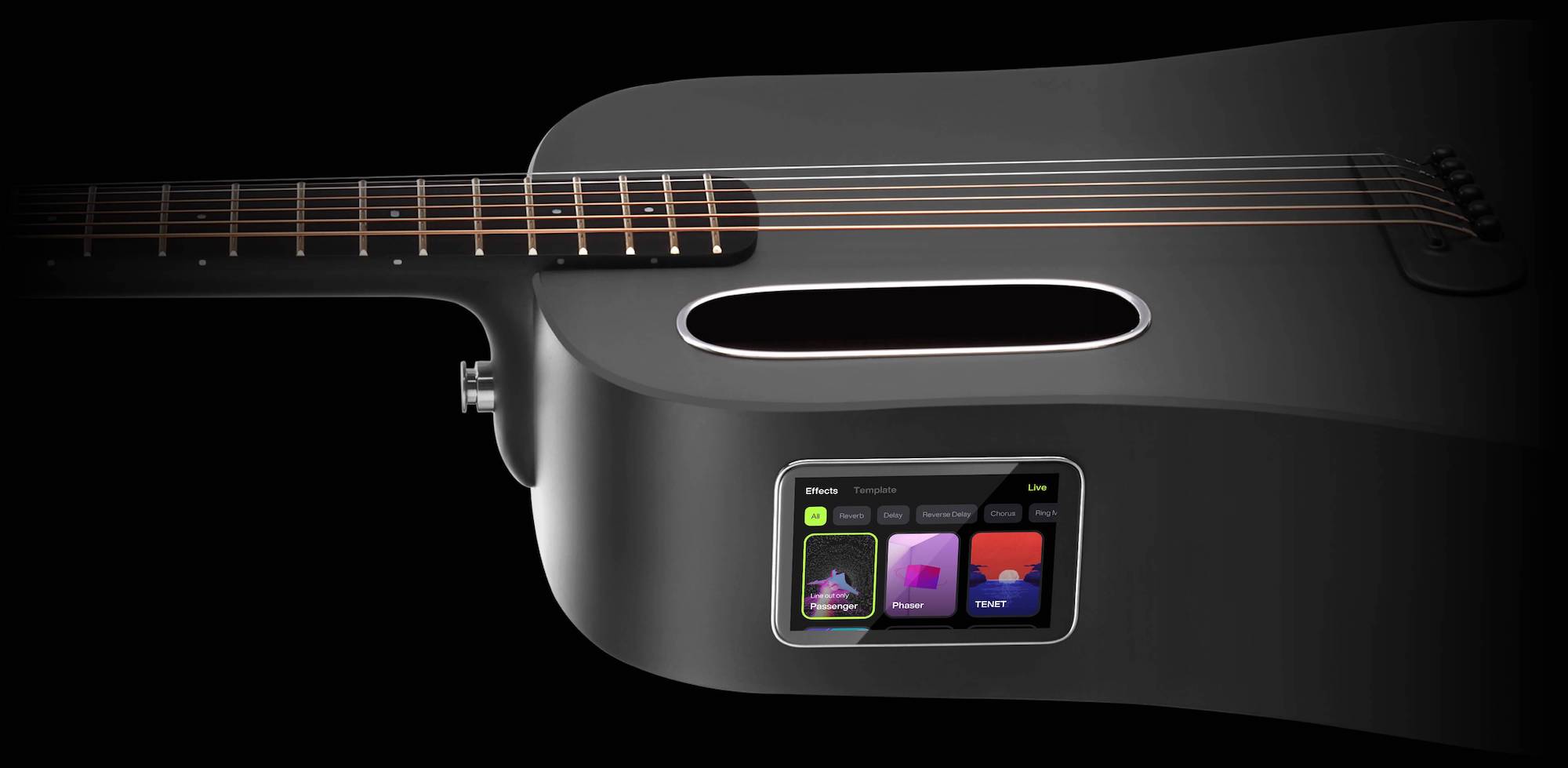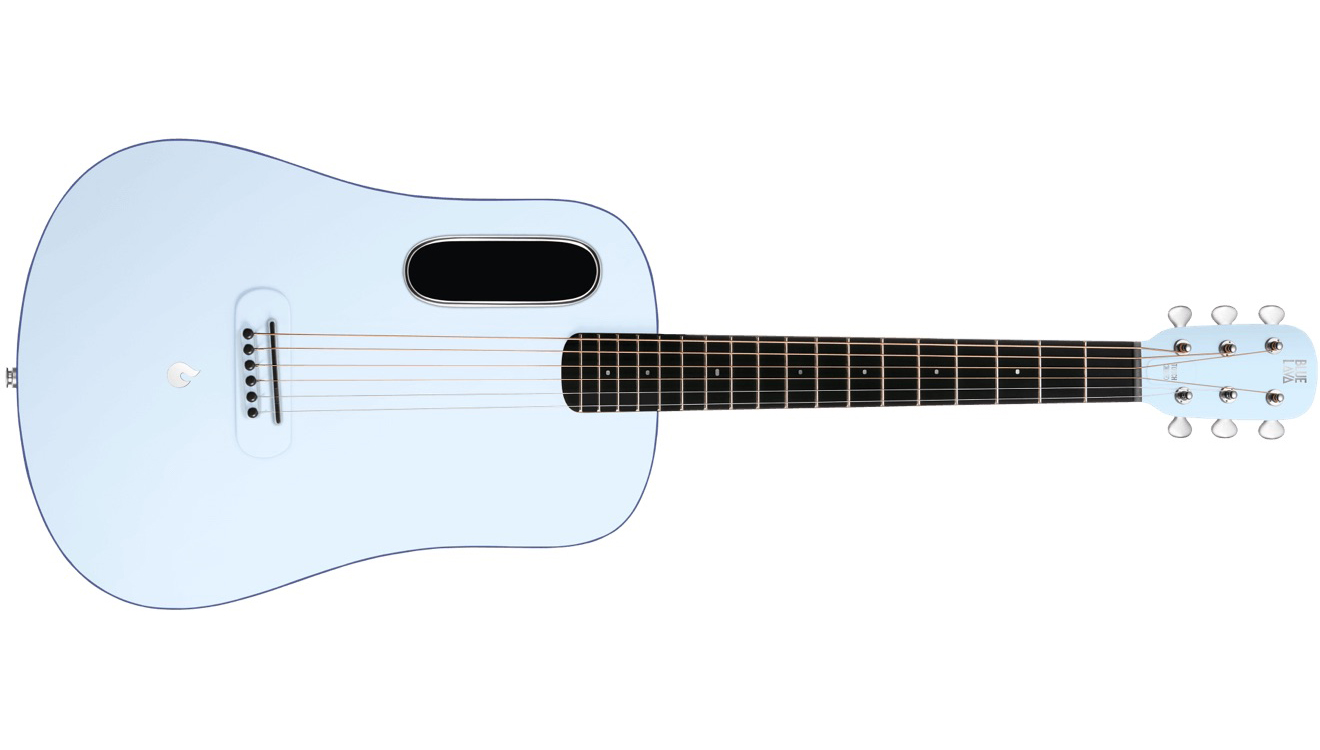GuitarPlayer Verdict
Pros
- +
Innovative, outstanding value. Groovy modern/vintage look, Robust parlor tone in travel size, fabulous playability. Dazzling onboard resonance effects plus recording, looping, practice program, & more. App syncs to guitar and connects online community
Cons
- -
Shelf life of sophisticated electronics. Battery capacity. Amplified tone significantly wetter than acoustic
You can trust Guitar Player.
Last month, we took a look at Lava’s first smart guitar, the ME 3, which won an Editors’ Pick Award. This month, we’ll carry on with the brand-new Blue Lava, which promises Lava’s considerable innovation in a slightly more conventional, smaller, and far more affordable package.
It features virtually the same insanely cool HILava software system, packed with amazing apps for onboard effects, recording, looping, tuning, and practice, as well as a phone app with a social media element. Despite all that, the guitar is decidedly different.
The Blue Lava is Lava Music’s first smart guitar made from high-pressure laminate with a bolt-on neck, rather than the unibody carbon-fiber design that has been the brand’s hallmark since 2017.
The Blue Lava is a compact companion that measures 36 inches long, and its two-toned, pop-art inspired aesthetic is eye-catching. Our review unit happened to be the Ice/Ocean Blue model, but the guitar is available in several other hues.
The most distinctive feature is the sound port, which looks like a stretched oval bound in metallic plastic located in the upper bout. A shiny logo apparently made from the same material lays below a painted bridge, while matte aluminum tuners line either side of a rounded headstock. To my eyes it looks like a vintage Danelectro or Gretsch crossed with the guitar equivalent of a Tesla.
The Blue Lava's neck is bolted to a wooden block inside the body, facilitating a nearly heel-less design similar to its unibody carbon cousins, and facilitating playability all the way to the top of its 18-fret ’board.
The neck is precise, with accurate intonation, which is rare for an affordable acoustic guitar with a short scale length. The Blue Lava’s tone belies its diminutive body size as well. It has none of the shrillness one might expect in the top end. The treble is actually quite tempered, the bass response is shockingly robust, and the mids balance everything out nicely.
You can achieve drastically different tones by changing plucking-hand positions from near the bridge, where it’s nice and bright, to near the top of the fingerboard, where it’s mellow. In any position, there’s a funky, flat kind of quality to its fundamental-forward tone that I felt matched the “future pawnshop prize” aesthetic, as I dubbed it in the last issue’s review.
The unique body shape takes a little getting used to, but it’s small enough to be lap-friendly, and once you get the ingenious Lava Ideal Strap 2 for Blue Lava (sold separately for $59) locked on, it’s super secure.
The star of the show is the HILava system with the L3 smart preamp, which operates like a simple smartphone implanted topside and loaded with guitar apps. Resonance-based effects turn the guitar into its own acoustic amp.

In addition to standard effects like reverb and delay, there are unique ones like Cry Baby and Banana Bass that offer everything from wah to octave effects and ring modulation, and which are even illustrated on the screen with fun graphics. Even the standard stuff is pretty tricked out, like the cavernous, cosmic reverb of Black Hole and the repetitious, clockwork-like delay of Big Ben. They’re tweakable too.
Given the organic nature of actuator-induced acoustic effects and the wild inclinations of Lava’s programming team, the resulting tones have a natural foundation with radical enhancement. The processing becomes much more prominent when you plug in, and that takes some getting used to.
Other apps include a multifaceted tuner, a customizable practice program with chord recognition and ear training, a flexible metronome, a looper that can be used with or without backing grooves, and an onboard recorder that can serve as a songwriting scratch pad, with up to four tracks. Lava even offers a social element for sharing creations with other users via the Lava+ app.
It pairs the guitar with an actual smartphone, where recordings and other functionality can be managed. [See last month’s review of the Lava ME 3 for a deeper dive into the electronics.] The Blue Lava delivers on Lava’s design goal to broaden the audience for its groundbreaking instruments. For those who simply don’t dig carbon fiber, here’s a similar guitar made of a high-pressure laminate composite that sounds and feels more wooden.
Lava claims that the Blue is nearly as weatherproof as its other instruments while being even more environmentally friendly due to the recyclable materials in the composite.
For those who want smart electronics at a much more affordable price, the Blue Lava offers almost the exact same system as the ME 3, the main differences being half the onboard storage capacity for your loops and tunes, and a battery with slightly more than half of the capacity. The Wireless Airflow Charger ($119 street) is helpful and acts as a handy stand with a fold-up design for portability.
Running time lasts about four to five hours per full charge and will diminish over time. That’s a concern, especially for gigging pros, but the Blue is definitely designed with more of the hobbyist or beginner in mind. That said, ace engineer and Go-Go’s guitar tech Travis Kasperbauer was way into it, and he dug it equally for being a killer acoustic.
Most folks I showed it to were intrigued, and many said something along the lines of having a brother, sister, niece, or nephew who would love that guitar. Of course, the main concern is about what’s going to become of the onboard processor that seems so smart now. This one froze up a few times and will age out eventually.
The good news is that the guitar alone is practically worth the price. Add in the awesome electronics and the Blue Lava is, like its ME 3 sibling, worthy of an Editors’ Pick Award.
Specifications
CONTACT: lavamusic.com
PRICE: $649 street with Lite Bag, $699 with AirFlow Bag
NUT: 1.72” wide
NECK: High pressure laminate
FRETBOARD: High pressure laminate, 23.5” scale
FRETS: 18
TUNERS: Lava matte aluminum, 18:1 ratio
BODY: High pressure laminate
BRIDGE: High pressure laminate
ELECTRONICS: HILava system with L3 smart preamp and FreeBoost 2.0 effects actuator, 2G memory, 16G storage
CONTROLS: Volume wheel and on/off/sleep/wake button inside sound port, 3 ½” multitouch screen on top side with status, menu, and app icons
ONBOARD APPS: Tuner, metronome, recorder, loops (grooves, not a looper), practice program, effects
EFFECTS: 50+ presets consisting of reverb, delay, reverse delay, chorus, tremolo, phaser, flanger, ring mod, octave, stutter, wah, slow gear, pitch shift, shaper filter, distortion, and impulse response for line out
LAVA+ APP: Syncs with HILava system via LavaCloud to keep track of effects templates, favorite grooves, practice summary, music, pictures, and devices plus top and trending recordings by other Lava players
CONNECTIVITY: Wi-Fi, Bluetooth, ¼” output jack, USB-C jack for charging, contact charging available via AirFlow Wireless Charger (sold separately, $119 street)
POWER: 5,000 mAh lithium-ion battery, USB-C to A cable provided, 15W USB-C charging adaptor not included
FACTORY STRINGS: Phosphor bronze, .012–.052
WEIGHT: 4.4 lbs (as tested)
BUILT: China
Jimmy Leslie has been Frets editor since 2016. See many Guitar Player- and Frets-related videos on his YouTube channel, and learn about his acoustic/electric rock group at spirithustler.com.
"We tried every guitar for weeks, and nothing would fit. And then, one day, we pulled this out." Mike Campbell on his "Red Dog" Telecaster, the guitar behind Tom Petty & the Heartbreakers' "Refugee" and the focus of two new Fender tribute models
“A good example of how, as artists, you have to blindly move forward with crazy ideas”: The story of Joe Satriani’s showstopping Crystal Planet Ibanez JS prototype – which has just sold for $10,000











